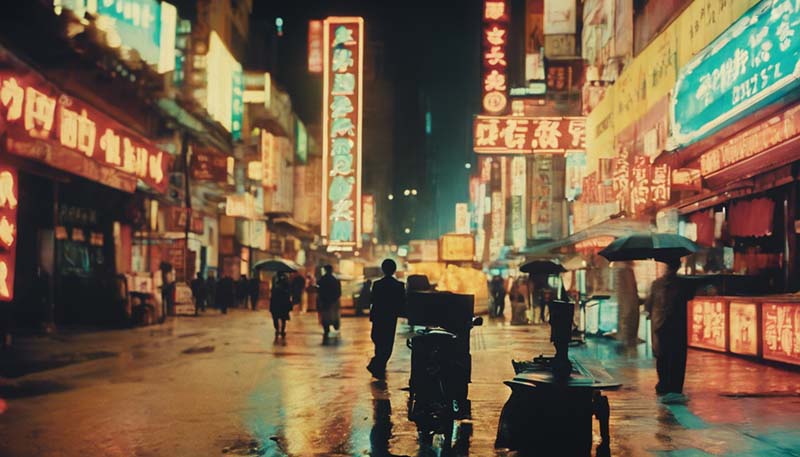The Poetic Cinema of Wong Kar-wai: A Study of His Dreamlike Aesthetic
The Poetic Cinema of Wong Kar-wai: A Study of His Dreamlike Aesthetic
Wong Kar-wai, a prominent figure in contemporary cinema, is renowned for his distinctive visual style and narrative techniques that have left an indelible mark on the film industry. This essay aims to explore the poetic nature of his cinema, focusing on the dreamlike aesthetic that permeates his work, creating a unique and immersive experience for the audience.
Introduction
Born in Shanghai and raised in Hong Kong, Wong Kar-wai's cinematic journey began in the 1980s. His films often explore themes of love, loss, and memory, employing a nonlinear narrative structure, visually stunning cinematography, and a poignant use of music. This essay will delve into the key elements that contribute to the dreamlike quality of his films, including visual style, narrative structure, and the use of music.
Visual Style
Color and Lighting
Wong Kar-wai's use of color and lighting is a significant aspect of his dreamlike aesthetic. His films are characterized by a rich, saturated color palette that evokes a sense of nostalgia and longing. The use of neon lights and contrasting shadows creates an atmosphere of mystery and intimacy, drawing the viewer into the world of his characters.
Camera Work
The fluid camera movements in Wong Kar-wai's films contribute to their poetic quality. His use of handheld cameras, slow-motion shots, and close-ups creates a sense of immediacy and emotional intensity. This intimate visual style allows the audience to connect with the characters on a deeper level, as if they are experiencing their emotions and memories firsthand.
Advertisement
Framing and Composition
Wong Kar-wai's films are known for their striking compositions and unique framing techniques. He often uses the rule of thirds and off-center framing to create a sense of imbalance and tension. This visual approach mirrors the emotional turmoil and yearning experienced by his characters, further enhancing the dreamlike quality of his films.
Narrative Structure
Nonlinear Narratives
One of the defining features of Wong Kar-wai's cinema is its nonlinear narrative structure. His films often move back and forth in time, with scenes and events presented out of chronological order. This fragmented storytelling mirrors the human experience of memory and emotion, allowing the audience to piece together the narrative as they navigate the characters' emotional journeys.
Character Development
Wong Kar-wai's characters are complex and multifaceted, often dealing with unrequited love, loneliness, and the passage of time. His films explore the inner lives of these characters, inviting the audience to empathize with their struggles and desires. This focus on character development adds depth to his films and contributes to their dreamlike quality.
Symbolism and Motifs
Symbolism and recurring motifs are integral to the poetic nature of Wong Kar-wai's films. Objects such as clocks, cigarettes, and mirrors serve as symbols that convey deeper meanings and emotional resonance. These motifs act as visual and thematic anchors, weaving together the narrative threads and reinforcing the dreamlike atmosphere of his films.
Use of Music
Soundtracks and Scores
Music plays a crucial role in Wong Kar-wai's films, often acting as a character in its own right. His use of music is highly emotive, with soundtracks and scores that complement and enhance the visual storytelling. The eclectic mix of genres, from pop and rock to traditional Chinese music, contributes to the dreamlike quality of his films, creating a unique auditory experience for the audience.
Diegetic and Non-diegetic Sound
Wong Kar-wai skillfully employs both diegetic and non-diegetic sound to create a layered sonic landscape. Diegetic sounds, such as the hum of a city or the rustle of the wind, immerse the audience in the film's setting. Non-diegetic music, on the other hand, serves to heighten the emotional impact of a scene, often evoking a sense of melancholy or longing that resonates with the characters' emotional states.
Conclusion
Wong Kar-wai's films are a testament to the power of cinema to evoke emotion and transport the audience to another world. His dreamlike aesthetic, characterized by a rich visual style, nonlinear narratives, and a poignant use of music, creates a unique and immersive cinematic experience. By exploring the poetic nature of his films, we gain a deeper appreciation for the artistry and vision that define Wong Kar-wai's contribution to the world of cinema.
References:

- Wong, K. (Director). (2000). In the Mood for Love [Motion Picture]. Hong Kong: Jet Tone Films.
- Wong, K. (Director). (1994). Chungking Express [Motion Picture]. Hong Kong: Jet Tone Films.
- Teo, S. (2005). Wong Kar-wai. London: British Film Institute.
- Wong, K. (Director). (1997). Happy Together [Motion Picture]. Hong Kong: Jet Tone Films.